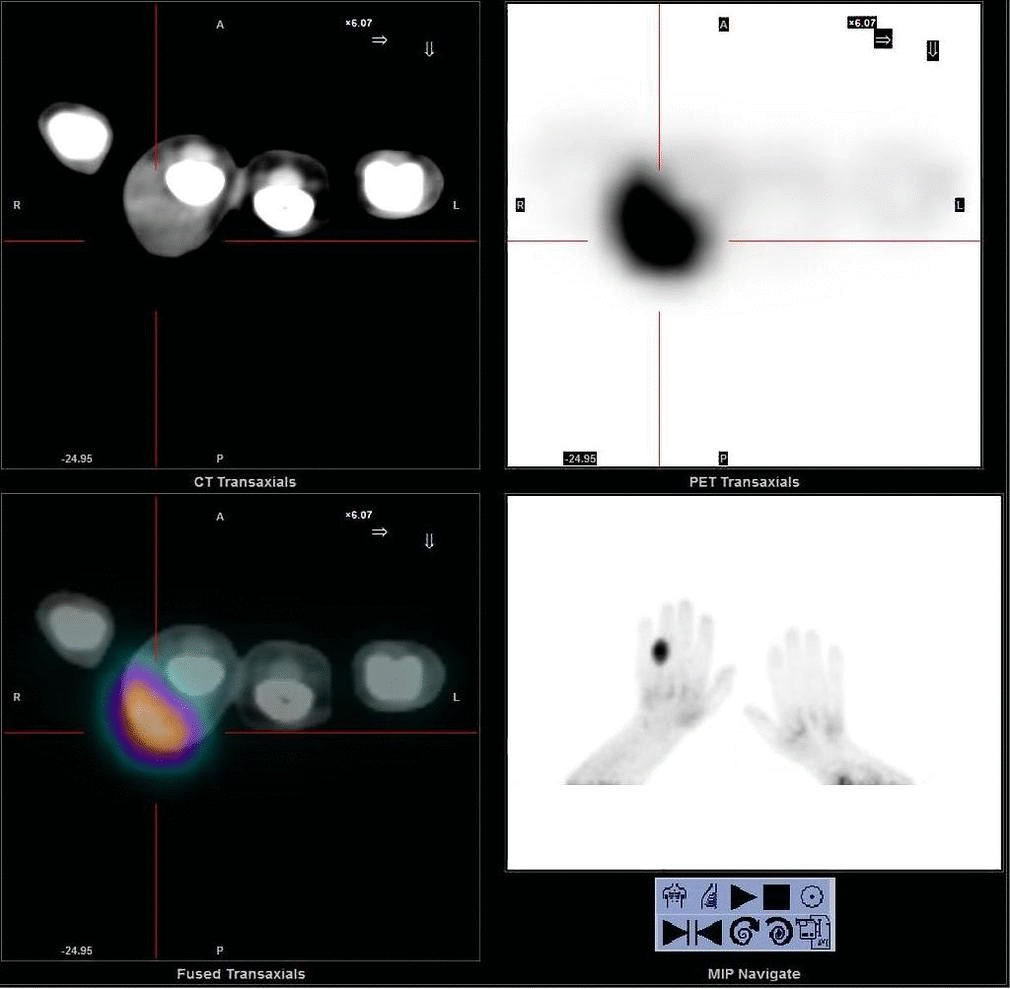Incidentaloma other imaging findings: Difference between revisions
No edit summary |
No edit summary |
||
| Line 17: | Line 17: | ||
* It may be helpful in the diagnosis of incidentaloma in selected patients; those with a history of [[malignancy]] or those in which [[Computed tomography|CT]] [[densitometry]] or washout analysis is inconclusive or suspicious for malignancy because of their high sensitivity for detecting malignancy.<ref name="pmid17287480">{{cite journal| author=Young WF| title=Clinical practice. The incidentally discovered adrenal mass. | journal=N Engl J Med | year= 2007 | volume= 356 | issue= 6 | pages= 601-10 | pmid=17287480 | doi=10.1056/NEJMcp065470 | pmc= | url=https://www.ncbi.nlm.nih.gov/entrez/eutils/elink.fcgi?dbfrom=pubmed&tool=sumsearch.org/cite&retmode=ref&cmd=prlinks&id=17287480 }}</ref> | * It may be helpful in the diagnosis of incidentaloma in selected patients; those with a history of [[malignancy]] or those in which [[Computed tomography|CT]] [[densitometry]] or washout analysis is inconclusive or suspicious for malignancy because of their high sensitivity for detecting malignancy.<ref name="pmid17287480">{{cite journal| author=Young WF| title=Clinical practice. The incidentally discovered adrenal mass. | journal=N Engl J Med | year= 2007 | volume= 356 | issue= 6 | pages= 601-10 | pmid=17287480 | doi=10.1056/NEJMcp065470 | pmc= | url=https://www.ncbi.nlm.nih.gov/entrez/eutils/elink.fcgi?dbfrom=pubmed&tool=sumsearch.org/cite&retmode=ref&cmd=prlinks&id=17287480 }}</ref> | ||
* 18F-FDG is not a specific [[marker]] for [[cancer]] cells but a marker only for increased [[glucose]] metabolism; thus, uptake can also be increased in cells with an increased energy requirement due to conditions other than cancer.<ref name="pmid21471169">{{cite journal| author=Terzolo M, Stigliano A, Chiodini I, Loli P, Furlani L, Arnaldi G et al.| title=AME position statement on adrenal incidentaloma. | journal=Eur J Endocrinol | year= 2011 | volume= 164 | issue= 6 | pages= 851-70 | pmid=21471169 | doi=10.1530/EJE-10-1147 | pmc= | url=https://www.ncbi.nlm.nih.gov/entrez/eutils/elink.fcgi?dbfrom=pubmed&tool=sumsearch.org/cite&retmode=ref&cmd=prlinks&id=21471169 }}</ref> | * 18F-FDG is not a specific [[marker]] for [[cancer]] cells but a marker only for increased [[glucose]] metabolism; thus, uptake can also be increased in cells with an increased energy requirement due to conditions other than cancer.<ref name="pmid21471169">{{cite journal| author=Terzolo M, Stigliano A, Chiodini I, Loli P, Furlani L, Arnaldi G et al.| title=AME position statement on adrenal incidentaloma. | journal=Eur J Endocrinol | year= 2011 | volume= 164 | issue= 6 | pages= 851-70 | pmid=21471169 | doi=10.1530/EJE-10-1147 | pmc= | url=https://www.ncbi.nlm.nih.gov/entrez/eutils/elink.fcgi?dbfrom=pubmed&tool=sumsearch.org/cite&retmode=ref&cmd=prlinks&id=21471169 }}</ref> | ||
[[File:PET CT.gif|300PX|left|thumb|PET-CT shows intense hypermetabolic lesion (SUVmax 6.3), source: Case courtesy of Dr Anna Margherita Maffione, Radiopaedia.org, rID: 33259]] | |||
==References== | ==References== | ||
{{Reflist|2}} | {{Reflist|2}} | ||
Revision as of 18:40, 28 August 2017
|
Incidentaloma Microchapters |
|
Diagnosis |
|---|
|
Treatment |
|
Case Studies |
|
Incidentaloma other imaging findings On the Web |
|
American Roentgen Ray Society Images of Incidentaloma other imaging findings |
|
Risk calculators and risk factors for Incidentaloma other imaging findings |
Editor-In-Chief: C. Michael Gibson, M.S., M.D. [1]; Associate Editor(s)-in-Chief: Mohammed Abdelwahed M.D[2]
Overview
Findings on a Positron Emission Tomography (PET-CT) scan suggestive of/diagnostic of incidentaloma. Cancer cells have an increased requirement for glucose and take up more glucose and deoxyglucose than normal cells. standard uptake value (SUV) values have been utilized to differentiate between benign and malignant adrenal lesions. It may be helpful in the diagnosis of incidentaloma in selected patients; those with a history of malignancy or those in which CT densitometry or washout analysis is inconclusive or suspicious for malignancy because of their high sensitivity for detecting malignancy.
Other Imaging Findings
- Findings on a Positron Emission Tomography (PET-CT) scan suggestive of/diagnostic of incidentaloma include:
- 18F-FDG-PET is a nuclear medicine modality that provides quantitative tomographic images after intravenous injection of a beta-radiation-emitting radiotracer (18-Fluorine) used to label 2-deoxy-d-glucose rendering fluoro-deoxyglucose (18F-FDG).[1]
- Both glucose and deoxyglucose enter cells via cell glucose transporters and undergo phosphorylation, but while glucose undergoes further enzymatic breakdown, deoxyglucose becomes trapped in intracellular compartments.
- Cancer cells have an increased requirement for glucose and take up more glucose and deoxyglucose than normal cells.[2]
- Quantitative measurement of 18F concentrations within tissues provides the most commonly used clinical measurement index, standard uptake value (SUV), which compares the intensity of uptake of 18F in the adrenal lesion to the average uptake of whole body.
- SUV values have been utilized to differentiate between benign and malignant adrenal lesions.
- It may be helpful in the diagnosis of incidentaloma in selected patients; those with a history of malignancy or those in which CT densitometry or washout analysis is inconclusive or suspicious for malignancy because of their high sensitivity for detecting malignancy.[3]
- 18F-FDG is not a specific marker for cancer cells but a marker only for increased glucose metabolism; thus, uptake can also be increased in cells with an increased energy requirement due to conditions other than cancer.[4]

References
- ↑ Groussin L, Bonardel G, Silvéra S, Tissier F, Coste J, Abiven G; et al. (2009). "18F-Fluorodeoxyglucose positron emission tomography for the diagnosis of adrenocortical tumors: a prospective study in 77 operated patients". J Clin Endocrinol Metab. 94 (5): 1713–22. doi:10.1210/jc.2008-2302. PMID 19190108.
- ↑ Becherer A, Vierhapper H, Pötzi C, Karanikas G, Kurtaran A, Schmaljohann J; et al. (2001). "FDG-PET in adrenocortical carcinoma". Cancer Biother Radiopharm. 16 (4): 289–95. doi:10.1089/108497801753131363. PMID 11602999.
- ↑ Young WF (2007). "Clinical practice. The incidentally discovered adrenal mass". N Engl J Med. 356 (6): 601–10. doi:10.1056/NEJMcp065470. PMID 17287480.
- ↑ Terzolo M, Stigliano A, Chiodini I, Loli P, Furlani L, Arnaldi G; et al. (2011). "AME position statement on adrenal incidentaloma". Eur J Endocrinol. 164 (6): 851–70. doi:10.1530/EJE-10-1147. PMID 21471169.